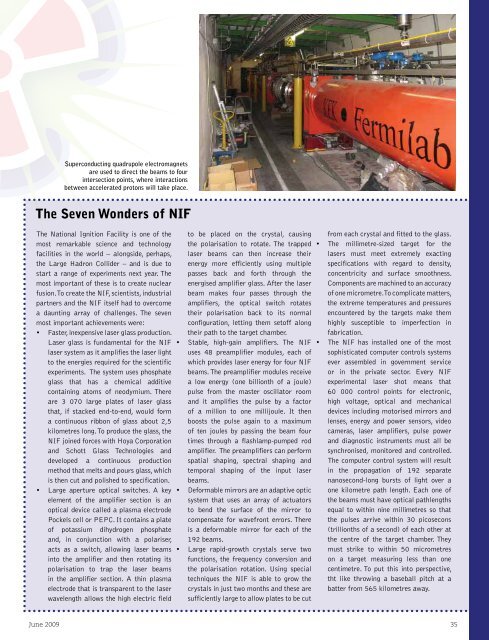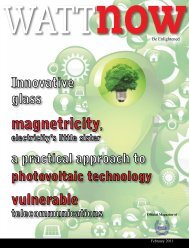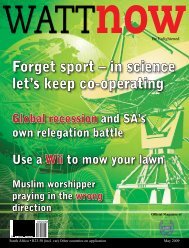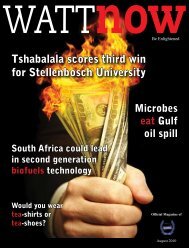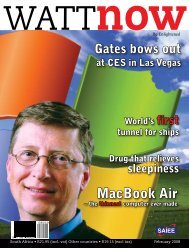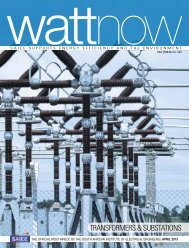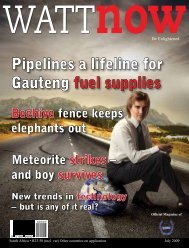download a PDF of the full June 2009 issue - Watt Now Magazine
download a PDF of the full June 2009 issue - Watt Now Magazine
download a PDF of the full June 2009 issue - Watt Now Magazine
- No tags were found...
You also want an ePaper? Increase the reach of your titles
YUMPU automatically turns print PDFs into web optimized ePapers that Google loves.
Superconducting quadrupole electromagnetsare used to direct <strong>the</strong> beams to fourintersection points, where interactionsbetween accelerated protons will take place.The Seven Wonders <strong>of</strong> NIFThe National Ignition Facility is one <strong>of</strong> <strong>the</strong>most remarkable science and technologyfacilities in <strong>the</strong> world – alongside, perhaps,<strong>the</strong> Large Hadron Collider – and is due tostart a range <strong>of</strong> experiments next year. Themost important <strong>of</strong> <strong>the</strong>se is to create nuclearfusion. To create <strong>the</strong> NIF, scientists, industrialpartners and <strong>the</strong> NIF itself had to overcomea daunting array <strong>of</strong> challenges. The sevenmost important achievements were:• Faster, inexpensive laser glass production.Laser glass is fundamental for <strong>the</strong> NIFlaser system as it amplifies <strong>the</strong> laser lightto <strong>the</strong> energies required for <strong>the</strong> scientificexperiments. The system uses phosphateglass that has a chemical additivecontaining atoms <strong>of</strong> neodymium. Thereare 3 070 large plates <strong>of</strong> laser glassthat, if stacked end-to-end, would forma continuous ribbon <strong>of</strong> glass about 2,5kilometres long. To produce <strong>the</strong> glass, <strong>the</strong>NIF joined forces with Hoya Corporationand Schott Glass Technologies anddeveloped a continuous productionmethod that melts and pours glass, whichis <strong>the</strong>n cut and polished to specification.• Large aperture optical switches. A keyelement <strong>of</strong> <strong>the</strong> amplifier section is anoptical device called a plasma electrodePockels cell or PEPC. It contains a plate<strong>of</strong> potassium dihydrogen phosphateand, in conjunction with a polariser,acts as a switch, allowing laser beamsinto <strong>the</strong> amplifier and <strong>the</strong>n rotating itspolarisation to trap <strong>the</strong> laser beamsin <strong>the</strong> amplifier section. A thin plasmaelectrode that is transparent to <strong>the</strong> laserwavelength allows <strong>the</strong> high electric fieldto be placed on <strong>the</strong> crystal, causing<strong>the</strong> polarisation to rotate. The trappedlaser beams can <strong>the</strong>n increase <strong>the</strong>irenergy more efficiently using multiplepasses back and forth through <strong>the</strong>energised amplifier glass. After <strong>the</strong> laserbeam makes four passes through <strong>the</strong>amplifiers, <strong>the</strong> optical switch rotates<strong>the</strong>ir polarisation back to its normalconfiguration, letting <strong>the</strong>m set<strong>of</strong>f along<strong>the</strong>ir path to <strong>the</strong> target chamber.• Stable, high-gain amplifiers. The NIFuses 48 preamplifier modules, each <strong>of</strong>which provides laser energy for four NIFbeams. The preamplifier modules receivea low energy (one billionth <strong>of</strong> a joule)pulse from <strong>the</strong> master oscillator roomand it amplifies <strong>the</strong> pulse by a factor<strong>of</strong> a million to one millijoule. It <strong>the</strong>nboosts <strong>the</strong> pulse again to a maximum<strong>of</strong> ten joules by passing <strong>the</strong> beam fourtimes through a flashlamp-pumped rodamplifier. The preamplifiers can performspatial shaping, spectral shaping andtemporal shaping <strong>of</strong> <strong>the</strong> input laserbeams.• Deformable mirrors are an adaptive opticsystem that uses an array <strong>of</strong> actuatorsto bend <strong>the</strong> surface <strong>of</strong> <strong>the</strong> mirror tocompensate for wavefront errors. Thereis a deformable mirror for each <strong>of</strong> <strong>the</strong>192 beams.• Large rapid-growth crystals serve tw<strong>of</strong>unctions, <strong>the</strong> frequency conversion and<strong>the</strong> polarisation rotation. Using specialtechniques <strong>the</strong> NIF is able to grow <strong>the</strong>crystals in just two months and <strong>the</strong>se aresufficiently large to allow plates to be cutfrom each crystal and fitted to <strong>the</strong> glass.• The millimetre-sized target for <strong>the</strong>lasers must meet extremely exactingspecifications with regard to density,concentricity and surface smoothness.Components are machined to an accuracy<strong>of</strong> one micrometre. To complicate matters,<strong>the</strong> extreme temperatures and pressuresencountered by <strong>the</strong> targets make <strong>the</strong>mhighly susceptible to imperfection infabrication.• The NIF has installed one <strong>of</strong> <strong>the</strong> mostsophisticated computer controls systemsever assembled in government serviceor in <strong>the</strong> private sector. Every NIFexperimental laser shot means that60 000 control points for electronic,high voltage, optical and mechanicaldevices including motorised mirrors andlenses, energy and power sensors, videocameras, laser amplifiers, pulse powerand diagnostic instruments must all besynchronised, monitored and controlled.The computer control system will resultin <strong>the</strong> propagation <strong>of</strong> 192 separatenanosecond-long bursts <strong>of</strong> light over aone kilometre path length. Each one <strong>of</strong><strong>the</strong> beams must have optical pathlengthsequal to within nine millimetres so that<strong>the</strong> pulses arrive within 30 picosecons(trillionths <strong>of</strong> a second) <strong>of</strong> each o<strong>the</strong>r at<strong>the</strong> centre <strong>of</strong> <strong>the</strong> target chamber. Theymust strike to within 50 micrometreson a target measuring less than onecentimetre. To put this into perspective,tht like throwing a baseball pitch at abatter from 565 kilometres away.<strong>June</strong> <strong>2009</strong> 35


